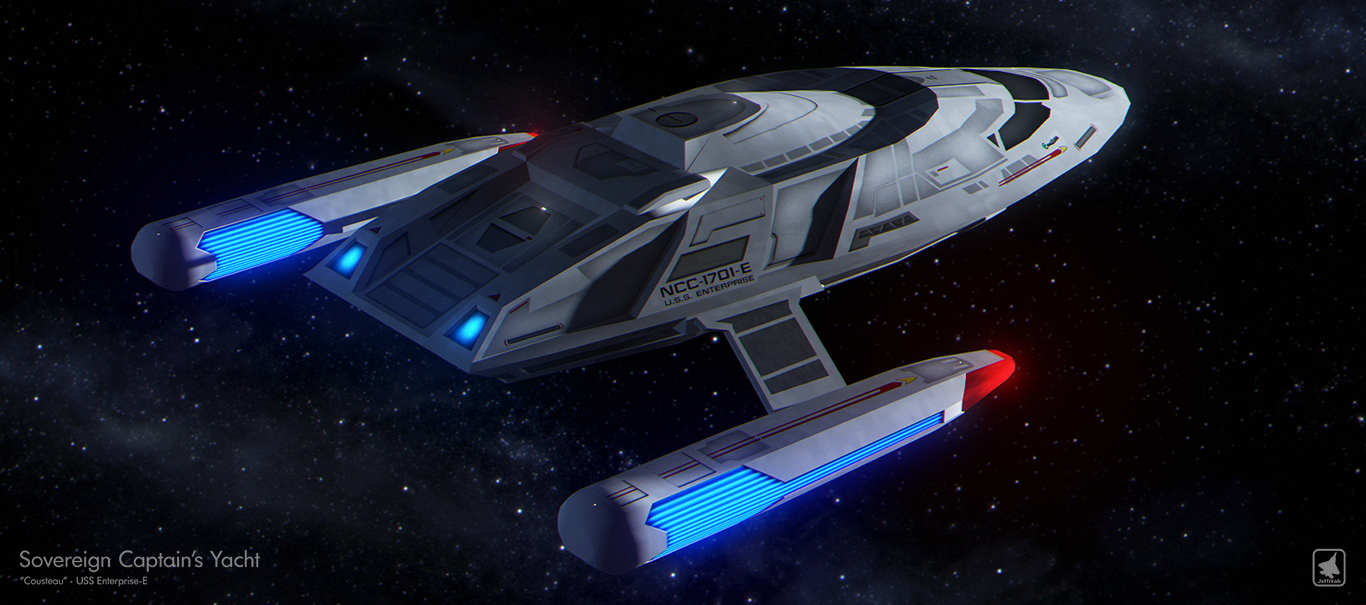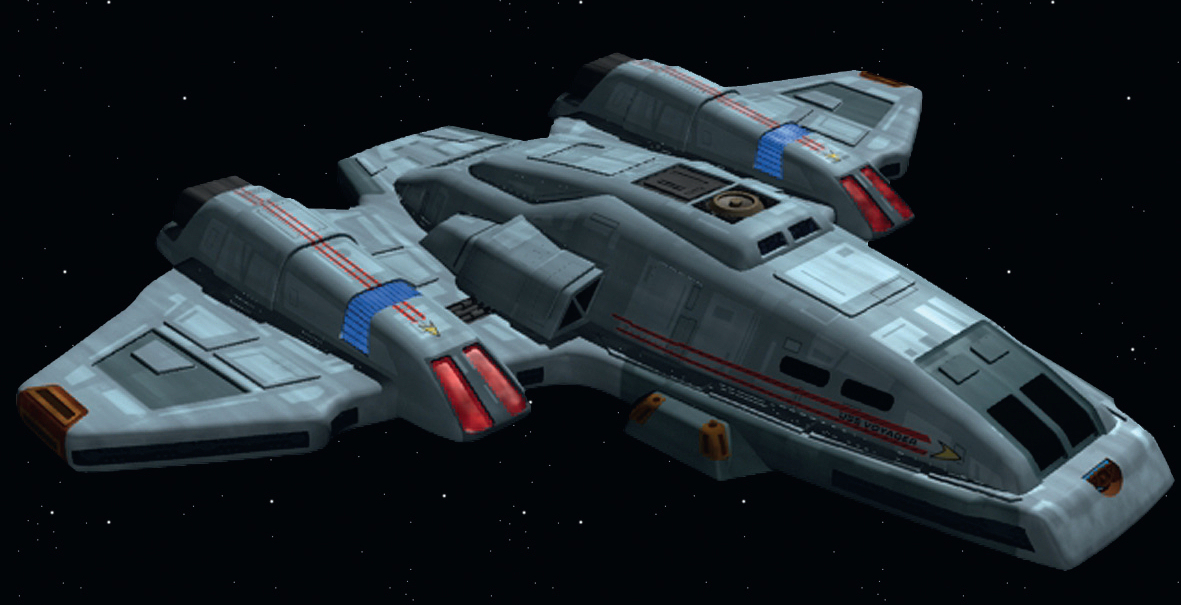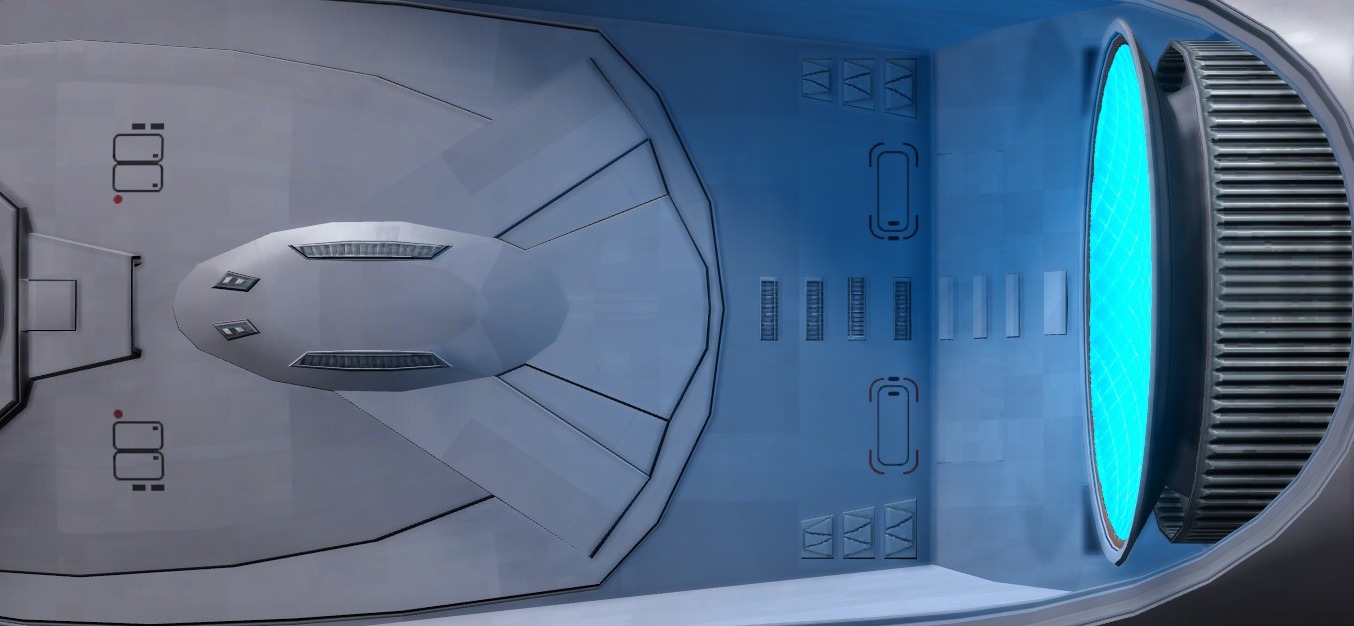Starship-Integrated Auxiliary Craft
Starship-Integrated Auxiliary Craft are small craft connected directly to the hull of a starship. This is almost invariably to allow a vessel to carry a craft larger than would be practical in its actual shuttle bays. These craft are occasionally found in other settings, as well.
Captain's Yachts
A captain's yacht is a craft set aside for the personal use of a vessel's commander. In nautical history, such a vessel would be used to transport the captain between a ship at anchor and the port. In Starfleet practice, these are used for away missions deemed necessary by the captain, for diplomatic transport missions, and, occasionally, for recreational purposes, as Starfleet recognizes the enormous pressure starship command places on its officers. Strictly speaking, the 'correct' Earth naval parlance would be for captains to have "gigs" and admirals to have yachts, but Starfleet parlance uses the same terminology for both captains and flag officers assigned a vessel of this type.
Galaxy-type Captain's Yacht

| |
| Galaxy-type Captain's Yacht | |
| Information | |
| Affiliation | |
| Role |
Diplomatic Transport |
| Service | |
| Operator | |
| Entered Service |
2345 |
| Production Ended |
2395 |
| Population | |
| Flight Crew |
4 |
| Passengers |
6 |
| Dimensions | |
| Length |
10 meters |
| Width |
18 meters |
| Height |
8 meters |
| Propulsion | |
| Propulsion Systems |
Impulse Engine |
| Shields |
Graviton Shielding |
| Template:Specification | |
Carried aboard Challenger, Cheyenne, Galaxy, Nebula, New Orleans, and Springfield-class starships, the Galaxy-type captain's yacht is a large, elliptical craft intended for short in-system missions or transport from orbit to a planet's surface. This impulse-only craft could sustain a crew of 2-4 and 4-6 passengers for several weeks, but could not conceivably reach another star system. In all of the classes that use it, the captain's yacht is docked in a special bay under the primary hull.
Atmospheric jets along the edge of the saucer provide lift, and and vector thrust from the ventrally mounted impulse engine to sustain level flight; at high speeds, the vessel must operate essentially on its side, perpendicular to the center of gravity of the planet it's flying over. This luxurious vessel is equipped with two staterooms for the captain or a principal guest, along with a smaller bunkroom for any aides, and another sleeping area for the crew. The bridge is located centrally.
In situations where the mothership must be evacuated, the captain's yacht is intended to serve as a command and control hub for the escape pods, as it has sufficient internal volume for emergency medical triage. In a pinch, this craft can also be used as the nexus of a planet-side research camp.
These craft were produced on a 1:1 basis with their motherships, and production ended in 2395 with the launch of the last Nebula-class heavy cruiser. Truly a relic of an era of hope, these unarmed and ungainly craft are very polarizing; some captains consider them to be a powerful symbol of the Federation and a personal trophy for commanding a mid-24th century starship, while others eschew their use completely.
California-type Captain's Yacht

| |
| California-type Captain's Yacht | |
| Information | |
| Affiliation | |
| Role |
Diplomatic Transport |
| Service | |
| Operator | |
| Entered Service |
2368 |
| Crew Capacity | |
| Flight Crew |
4 |
| Passengers |
6 |
| Dimensions | |
| Length |
33.5 meters |
| Width |
24 meters |
| Height |
6.3 meters |
| Propulsion | |
| Propulsion Systems |
Matter/Antimatter Warp Engine |
| Cruise Speed |
Warp 5 |
| Shields |
Graviton Shielding |
| Template:Specification | |
California and Parliament-class starships share a design of yacht which blends characteristics of the Danube-class runabout and the Type-6A shuttlecraft. Decidedly less luxurious than the Galaxy-type, they are more utilitarian while still being used the captain's personal discretion. They are substantially faster than the standard shuttles carried by these vessels, so they are excellent for situations where the commanding officer must be somewhere quickly or for performing important away missions. Yachts are stored in small launch bays on the underside of the saucer section just large enough to accommodate the yacht itself and a small boarding area.
These yachts have two staterooms and a lounge area, but devote a significant amount of space to cargo or equipment storage, reflecting their dual nature.
Sovereign-type Captain's Yacht

| |
| Sovereign-type Captain's Yacht | |
| Information | |
| Affiliation | |
| Role |
Diplomatic Transport |
| Service | |
| Operator | |
| Entered Service |
2372 |
| Crew Capacity | |
| Flight Crew |
4 |
| Passengers |
6 |
| Dimensions | |
| Length |
33.5 meters |
| Width |
26.2 meters |
| Height |
6.3 meters |
| Propulsion | |
| Propulsion Systems |
Matter/Antimatter Warp Engine |
| Cruise Speed |
Warp 6 |
| Maximum Speed |
Warp 8 |
| Armaments | |
| Energy Weapons |
|
| Shields |
Graviton Shielding |
| Template:Specification | |
The Sovereign-type captain's yacht shares its overall hull shape with the earlier California-type yacht, but with foldable warp nacelles that allow it to dock on the underside of the Sovereign's torpedo turret. Reflecting the era in which it was designed, it is armed with phaser arrays that allow it to conduct dangerous missions. It is also one of the fastest small craft in Starfleet's inventory.
As with the California-type, these yachts have both staterooms and space for cargo or equipment storage. They are capable of being outfitted for passenger-only travel for longer-duration missions, or for transporting critical goods very quickly. This was the first yacht class to be produced as a stand-alone craft, and many of them are found at major starbases for the use of important officers.
Luna-type Captain's Skiff

| |
| Luna-type Captain's Skiff | |
| Information | |
| Affiliation | |
| Role |
Diplomatic Transport |
| Service | |
| Operator | |
| Entered Service |
2379 |
| Crew Capacity | |
| Flight Crew |
4 |
| Passengers |
6 |
| Dimensions | |
| Length |
28 meters |
| Width |
24 meters |
| Height |
6.3 meters |
| Propulsion | |
| Propulsion Systems |
Matter/Antimatter Warp Engine |
| Cruise Speed |
Warp 5 |
| Shields |
Graviton Shielding |
| Template:Specification | |
Smaller and slower than the Sovereign-type yacht, but more luxurious than the California-type yacht, the Luna-type skiff is luxurious and is intended for purely diplomatic duties, lacking armaments or the space to embark extra equipment. It is stored between the planetary sensor dome and the main deflector on the underside of the Luna's primary hull. This craft takes inspiration from the Aeroshuttle and Waverider designs, with lift-generating wings and a sleek fuselage, but with furnishings and finishes geared towards high-end diplomacy rather than science.
Integrated Runabouts
Integrated runabouts are general purpose craft intended for extended away missions and planetary exploration. They are generally more capable than captain's yachts at these tasks, but are also less luxurious.
Aeroshuttle

| |
| Aeroshuttle | |
| Information | |
| Affiliation | |
| Role |
Research Support |
| Service | |
| Operator | |
| Entered Service |
2370 |
| Crew Capacity | |
| Flight Crew |
8 |
| Dimensions | |
| Length |
24.8 meters |
| Width |
29.6 meters |
| Height |
4.1 meters |
| Propulsion | |
| Propulsion Systems |
Matter/Antimatter Warp Engine |
| Cruise Speed |
Warp 7 |
| Armaments | |
| Energy Weapons |
4 Type-VII Phaser Arrays |
| Shields |
Graviton Shielding |
| Template:Specification | |
Developed in tandem with the Intrepid-class light explorer, Aeroshuttles are large runabouts intended for planetary surveys and other exploratory tasks independent of their mothership. The overall design borrows much from the Danube-class runabout, with hot-swappable modules traded for a fully-integrated hull design that includes wings and oversized thruster quads for atmospheric flight.
Extensive sensor pallets line the Aeroshuttle and the onboard computers are linked directly with their mothership's systems to provide fast and effective data collection. This craft uses a novel integrated warp-impulse system which expels warp plasma through the end of the nacelles for incredible sublight speeds, at the cost of overall efficiency and endurance. Warp speed is also impressive for her size, again at the cost of range.
An Aeroshuttle can comfortably support a mission crew of up to eight, with two bunk rooms and an aft living area. The cockpit is borrowed directly from the Danube, and the amidships space is taken up by a small laboratory.
Aeroshuttles are built as stand-alone vehicles and are often assigned to support research stations. They are now also integrated into the Pathfinder-class long-range science vessel. With both the Pathfinder and the Intrepid, the Aeroshuttle docks seamlessly with the underside of the primary hull.